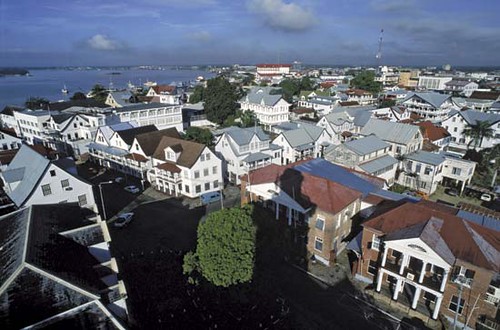Suriname might just be one of the most interesting places you have never heard of!
If you are a tourist trail weary traveler, this is good news indeed. Suriname is a fascinating destination on the North East coast of South America.
Think tropical, diverse, Caribbean influences, bauxite, gold… If you like to get off the beaten track, the country should definitely be on your bucket list. Is your curiosity aroused? Well then, keep reading and you will discover 7 surprisingly interesting facts about Suriname.
Suriname might just be one of the most interesting places you have never heard of!
If you are a tourist trail weary traveler, this is good news indeed. Suriname is a fascinating destination on the North East coast of South America.
Think tropical, diverse, Caribbean influences, bauxite, gold… If you like to get off the beaten track, the country should definitely be on your bucket list. Is your curiosity aroused? Well then, keep reading and you will discover 7 surprisingly interesting facts about Suriname.
#1: Recently Discovered Petroglyphs Deep in the Jungle
Werehpai is an atmospheric network of several caves containing 313 petroglyphs. The other 25 known petroglyph sites in Suriname contain a total of 192 petroglyphs between them. This makes the Werehpai site a significant discovery. As well as discovering the petroglyphs pottery was excavated at the site that dated back 3,000 years.
Deep in the Southern jungles of the country, where there is little infrastructure beyond the rivers, getting to Werehpai is going to be an adventure. That is before you even see the site. I am sure the numbers of travelers going to Werehpai is going to increase very quickly. My advice is get there as soon as possible to pre-empt the rush.
#2: Expect to Hear a Musical Cacophony of Language When You Visit
Suriname is Dutch speaking officially, plus there are five widely spoken recognized languages, and another nine recognized regional languages. I think even for bilingual Europeans that will be quite impressive. Particularly, considering the population of the country is only around 500,000!
Suriname is a very diverse country, even for diverse South America. The five recognized languages widely in use are Sarnami Hindustani (Caribbean Hindustani), English, Sranan Tongo Creole, Javanese, and Saramaccan.
The languages represent some of the different groups of people living in Suriname:
- Sarnami Hindustani: South Asian’s – Brought into the country as laborers when slavery was abolished, many South Asian’s speak a form of Hindi with a few differences. For example the language can be described as syllabic instead of vocalic
- Sranan Tongo Creole: Everyone (almost) – Due to the many different ethnic groups in Suriname a pidgin language has developed which almost everyone uses, as well as using their own particular language at home. Sranan Tongo Creole can be described as a mix between English, Dutch, Portuguese, and West African languages
- Javanese: Indonesians – Came to Suriname from Java via the Dutch West Indies as laborers when slavery was abolished
- Saramaccan: Ethnic Africans – This group descent from escaped African slaves (see #3). They have their own language and several dialects within the language.
#3 – A Group of People Known as the “Maroons” are descended from Escaped African Slaves
Maroons are one of the groups of people living in Suriname, mostly along the rivers in the tropical interior. Originally, they were West African escapees from slavery. They disappeared into the interior of the country, survived and settled. The earliest groups began to establish themselves in the earliest 17th century.
Often, co-operating with the indigenous people of Suriname they would ambush the colonialist when they ventured into the interior, and waged a kind of guerrilla warfare against the colonialist (hooray!). As a result the colonialist made a peace treaty with them. Therefore, they gained their official freedom in 1760 around 103 years before slavery was abolished in Suriname.
What makes this group of people so inspiring and interesting is that despite the fact returning home was impossibility for escapees, they were able to survive and adapt to the jungles of Suriname. They were able to live a free life, at the same time preserving elements of their African culture.
#4 – Suriname was a Dutch Colony, but the British Landed First
The first European attempt to colonize Suriname was actually a British one.
In 1630 Captain Marshall attempted to cultivate tobacco. This “venture” failed and was later followed by Lord Willoughby, the governor of Bermuda who established a colony in 1650. The colony promised religious freedom and attracted Brazilian Jews as well as other Europeans to join its ranks. In 1967 the Willoughbyland colony was attacked and conquered by the Dutch.
From 1967 the Dutch took increasing control over the area using slaves to build and work their plantations. After the abolishment of slavery, they used immigrant laborers mostly from Asia. Suriname was liberated from Dutch rule in 1975. However, this has not meant a smooth transition of power for the country, and they have suffered periods of turmoil, dictatorial rule and a couple of coups.
#5 – Three Major Religions are practiced: Islam, Christianity and Hinduism
Another reflection of the diversity in Suriname is the religions that are followed. Three major world Religions are represented in the country: Christianity, Islam and Hinduism. The greatest numbers of people are Christian, followed by Hindu’s and then Muslims. There are also Jews in Suriname, their population possibly dating back to the first colony.
As well as the major religions, indigenous people and the Maroons follow different beliefs. Some of the indigenous people living in the jungles worship living things through Piaiman, the medicine man. Whereas the Maroons have a ceremony called Winte through which they worship nature and their ancestors.
#6 – Suriname is Home to a Pristine Jungle Reserve you can Hardly Reach
Another reflection of the diversity in Suriname is the religions that are followed. Three major world Religions are represented in the country: Christianity, Islam and Hinduism. The greatest numbers of people are Christian, followed by Hindu’s and then Muslims. There are also Jews in Suriname, their population possibly dating back to the first colony.
As well as the major religions, indigenous people and the Maroons follow different beliefs. Some of the indigenous people living in the jungles worship living things through Piaiman, the medicine man. Whereas the Maroons have a ceremony called Winte through which they worship nature and their ancestors.
#6 – Suriname is Home to a Pristine Jungle Reserve you can Hardly Reach
The Central Suriname Nature Reserve is an exceedingly difficult to access huge area of pristine jungle. The area is a UNESCO world heritage site and home to a huge range of flora and fauna. Due to the difficulty of access, human impact has been minimal and even to the point the area itself is not that well surveyed.
Every conservation project that has managed to explore the area has discovered new species, many of which are endemic to the area. Some of the most famous inhabitants are the Jaguar, Giant River Otters, Giant Armadillos, Tapir, Sloths, Harpy Eagle. I could go on.
#7 A Food Bonanza to Satisfy the Most Culinary Curious
I am not sure if I mentioned already that Suriname is really diverse. : P. Well, if you didn’t quite get it yet, then here comes something about the food.
Firstly, there is an abundance of vegetables, fruits, sea food and meat. This quantity of ingredients combined with influxes of people from all corners of the globe has produced a widely varied food culture.
From African plantain dumplings (tom-tom) to Chinese spiced chicken (tja kai) to Native Indian cassava cakes (lolo casaba) to European chicken pasty (kippenpastei) to Indian spicy mango chutney to Lebonese stuffed cabbage rolls to Javanese noodles with chicken (bami ket kip), there is one thing for certain. Your taste buds are never going to get bored.
Now, You Might be thinking…
How is it I have never heard of Suriname before?!
Needless to say, I hope I have given you some idea of how the country is endlessly fascinating and overlooked destination. Which, if you are anything like me makes for a dream destination.
Have you ever been to Suriname? What was your favorite place/or experience? Which was your favorite meal? Or if you haven’t been would you like to visit? Do share with us your experiences and if you have any surprising tid-bits of knowledge to share about Suriname let us know in the comments… I can’t wait to hear from you all.



